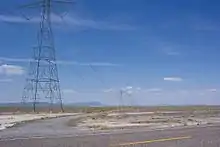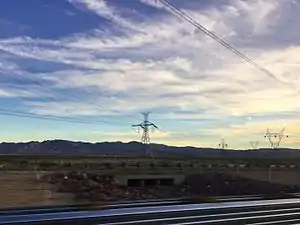Path 27
Path 27, or the Intermountain Power Project DC Line (IPP DC Line), or the Southern Transmission System is a HVDC transmission line that carries electricity from the Intermountain Power Plant near Delta, Utah to the city of Los Angeles via the Adelanto Converter Station in Adelanto, California. It is owned and operated by the Intermountain Power Agency, a large cooperative primarily owned by the Los Angeles Department of Water and Power (50%) along with five other Los Angeles area cities (25%) and 30 small Utah municipalities (remaining 25%).[1][2]

It is a bipolar overhead power line 488 miles (785 km) long, and can transfer a maximum power of 2,400 megawatts at ±500 kV. The part of the line that travels through the Mojave Desert is followed by many other AC 500 kV lines and Interstate 15.
The Pacific DC Intertie is the other HVDC line serving Los Angeles. HVDC lines such as the Intermountain line and the Pacific DC Intertie can be distinguished by having two transmission wires, rather than the three necessary for transmission of three phase AC power.
History
ABB Group, a Swiss-Swedish multinational corporation headquartered in Zürich, Switzerland, was the primary entity commissioned for this turnkey project in the mid-1980s. ABB also had responsibility for the converter stations, which were commissioned in April 1986.
In 2008, ABB received the order for an additional upgrade. This upgrade included delivery of the MACH2 control and protection system along with additional AC filters and cooling systems. This upgrade has allowed the link to reach a transmission capacity of 2400 MW (2.4 GW).
Solar Development
Energy Capital Group, LLC (ECG) is developing ECG Utah Solar 1, LLC, a 300 MW-AC PV solar plant strategically sited to utilize existing interstate transmission infrastructure on 1754 acres leased from the Utah School and Institutional Trust Lands (SITLA) less than one mile from the Intermountain Power Project (IPP) north of Delta, Utah.[3]
The project's planned interconnection point is the IPP switchyard which is a point of delivery for the Los Angeles, Anaheim, Riverside, Pasadena, Glendale and Burbank utilities. The switchyard connects to the Southern Transmission System (STS) the 500 HVDC line (Path 27) that travels 488 miles directly to a switchyard in Adelanto, Ca (see map). LADWP is a California Balancing Authority and operates the switchyard which makes this project as though it is on California soil for the state Renewable Portfolio Standard (RPS).
Allocation
| LADWP | 59.5% |
| Anaheim | 17.7% |
| Riverside | 10.2% |
| Pasadena | 5.9% |
| Burbank | 4.5% |
| Glendale | 2.3% |
Route

From the south, the Intermountain DC circuit starts at the Adelanto substation and static inverter plant. The line heads east for a short distance, until two 500 kV and one 287 kV powerlines (all carrying LADWP Path 46 power) meet the DC line from the Victorville substation. Together, the four lines head generally northeast, paralleling the Interstate 15 corridor and crossing the highway at two places in the California High Desert region. An additional line, called Path 64, but also part of Path 46, joins the four lines for a short distance near Newberry Springs before turning eastward and running closer to the Interstate 15 until the California-Nevada state line.
The DC line, two 500 kV lines, and the 287 kV line cross over the Interstate 15 again north of Primm and rejoin Path 64 and other powerlines northeast of the community before heading into Eldorado Valley. There, the AC lines terminate at McCullough, Marketplace, and Mead substations while the DC line bypasses these facilities. Two 500 kV AC lines originating from McCullough and Mead substations then join the DC line to head further north. They cross U.S. Route 95 in Henderson with one of 500 kV AC lines on double-circuit towers. These lines run east of the Las Vegas Valley. Just short of crossing I-15 for another time north of the Las Vegas region, one 500 kV line splits off for the Harry Allen Generating Station. One 500 kV line comes back from Harry Allen plant and rejoins the other 500 kV line at Crystal substation. Another 345 kV line from the Harry Allen Plant also runs parallel with the lines to head into Utah.
The lines then run northeast together somewhat north of I-15, until about 10 miles northwest of Mesquite, where the 500 kV AC (Path 21) line abruptly turns east, spanning the Virgin River to head to the Navajo Generating Station. The DC line continues north-northeast as the line crosses high mountains and large desert basins until it turns east in west-central Utah and terminates at the Intermountain Power Plant.
Electrodes and Electrode Lines
The electrode line from Adelanto Static Inverter Station is carried for 84.5 kilometres on the shield wire positions of the pylons. South of Coyote Lake at 34°57′36″N 116°41′49″W the electrode line branches on steel tube poles northward and ends at 35°1′17″N 116°41′43″W. The electrode line from Delta Static Inverter Station is carried for 44 kilometres on the shield wire positions of the pylons. At 39°18′57″N 112°54′20″W the electrode line branches westward to the grounding electrode situated at 39°18′58″N 112°55′18″W. Both electrode lines consist of two 908 mm2 Falcon conductors, mounted on ANSI Class 52-5 porcelain insulators. Each electrode consists of 60 deep wells with a depth of 87 metres in Delta and 60 metres in Coyote Lake covering an area of approximately 0.65 km2.
See also
References
- Roth, Sammy (2019-07-11). "Los Angeles is finally ditching coal — and replacing it with another polluting fuel". Los Angeles Times. Retrieved 2020-08-19.
Utah’s Intermountain Power Agency owns the coal plant and the power line, known as the Southern Transmission System.
- "Participants & Service Areas". Intermountain Power Agency. Retrieved 2020-08-19.
- http://www.kcet.org/news/redefine/rewire/solar/photovoltaic-pv/ladwp-may-be-buying-utah-sun.html
- Route description is based on Google Earth images
External links
| Wikimedia Commons has media related to Path 27 (Western Interconnection). |
